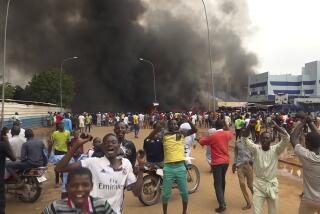Soviet Coup Doomed, U.S. Officials Believe : Outlook: Some intelligence analysts say the plotters lack a vital tool--the willingness to be ruthless.
- Share via
WASHINGTON — Less than 48 hours after the coup against Soviet President Mikhail S. Gorbachev, senior U.S. officials have advised President Bush that the Soviet hard-liners probably cannot sustain their grip on power and their rule is likely to unravel as a result of internal friction, public opposition and an inability to solve the country’s desperate economic problems.
Some ranking Administration officials said Tuesday that an attempt could be made soon to seize Boris N. Yeltsin, the popular president of the Russian Federation. He is the coup leaders’ most visible opponent and the man most capable of rallying popular support against them.
But even if Yeltsin is arrested and the coup succeeds in the short run, they said, it is unlikely to survive for more than a few months. “The coup isn’t over by any means, but they (its leaders) appear to be creating a situation that could be fatal,” a senior official said.
Some intelligence analysts suggested that the KGB, Soviet military and other security officials who have led the coup may no longer be able to take the kinds of ruthless action that have characterized Soviet security forces in the past.
“The coup isn’t oriented to do the hard things a coup usually does,” a ranking U.S. official said Tuesday. “The indications are they haven’t got their act together enough to be totally repressive.”
Added Soviet specialist Michael Beschloss: “The way it was done . . . was very half-hearted. The atmosphere suggests that they were not equipped with the steel nerve to press through no matter what happens, no matter what the bloodshed.”
“They’ve been tentative,” one government analyst said.
In part, U.S. officials believe, this reflects the coup leaders’ desire to preserve a facade of legitimacy and avoid arousing a traditionally lethargic populace. It also reflects uncertainty about the loyalty of Soviet military forces as a whole, although the new Kremlin regime clearly has control of at least some elite KGB security police and army units, officials said.
“They didn’t use the military too smartly because they weren’t too sure of the military,” said a senior U.S. Soviet analyst. “If they try to use the army, will the army respond?”
The conclusion that the coup is at a crucial point and may well fail is behind the tough position that Bush has taken--first in a statement Monday afternoon, then in his press conference Tuesday morning--denouncing the coup leaders as “usurpers” and “illegal” and strongly supporting Yeltsin’s position.
By contrast, Bush took a far milder stance two years ago when hard-line Chinese Communists cracked down on that country’s democracy movement, partly because the President at that point had concluded that the Chinese movement, led by students with limited support within the government, had no chance of success.
U.S. specialists now believe the only way the Kremlin coup can survive for long is through severe repression throughout the Soviet Union--probably with bloodshed.
Yet the use of force is also likely to destroy the unity within the ruling Emergency Committee, which may already have been demonstrated Tuesday in unconfirmed reports of resignations from the group.
U.S. officials said that Yeltsin’s continued direction of the anti-coup forces from the Russian Parliament building Tuesday is at the heart of the coup leaders’ dilemma.
“The one big thing in the equation that is unfriendly to them is Yeltsin,” said a senior government official. “As long as he’s whipping up a storm, he’s a menace to the coup. If they take him prisoner, they would create a firestorm of public uprising.”
Non-government experts on the Soviet situation voiced a similar sense that the coup plotters may have overplayed their hand. Having failed immediately to crush resistance from Yeltsin and others, they are now at a key juncture, said Arnold Horelick, senior Soviet specialist at the RAND Corp. in Santa Monica.
“If they don’t act within the next couple of days, then the coup will begin to unravel. . . . Something has to give one way or the other,” he said.
The apparent wavering by the new regime is best demonstrated by the tentative nature of the way its leaders dealt with Yeltsin during the first two days, U.S. analysts said.
While clearly aware of the menace Yeltsin poses and anxious to deal with it, leaders of the coup appear to have hoped that they would meet only light resistance that could be quelled by KGB and Interior Ministry forces without reliance on the Soviet army.
Faced with the prospect of having to rely on the army, they seem to have waffled.
“They don’t want to have a military onslaught,” said one U.S. official. “They don’t want to take a building and have indiscriminate casualties.”
Indeed, the first official reporting out of Moscow has led Bush Administration officials to conclude that the coup, carried out by eight powerful men and the Soviet Union’s three most repressive institutions, was poorly planned and hastily carried out, despite some indications that it was under consideration for months.
The three institutions include the KGB intelligence agency, the Interior Ministry and the army. Administration and private analysts now believe that the KGB was originally the strongest and most coherent agency behind the coup.
“It looks like the KGB is probably at the center of it. They appear to be the most coherent of the organizations involved,” said John D. Steinbruner, director of foreign policy studies at the Brookings Institution, a Washington think tank. “The army is too divided and the interior minister is on board but would not by themselves have the nerve to do this. The KGB has to be the major part.”
And Bush’s advisers say that the coup group’s original unity will be short-lived.
“They had one common interest on the agenda--preventing what they saw as the first step toward dismantling the Soviet Union,” said one U.S. official. “But beyond that, there’s every indication that they didn’t have a program or a cohesive plan.”
Administration officials and U.S. analysts said that fractures in the ruling Emergency Committee and divisions in the military--mainly over the use of force in keeping the junta in power--have virtually doomed the coup.
Cracks among ranking army officials have already been visible and there is a wide divergence of loyalties within the lower ranks, officials and experts said.
“There is no way this coalition can hold together. Within the coalition, especially in the army and even in the KGB, there are a lot of fissures and cleavages. It is not a unified group and that is already beginning to show,” said Harley Balzer, director of Russian studies at Georgetown University.
Different members of the ruling group have varying visions of the Soviet Union’s future. “Some of them would like to roll the clock back to 1989, others to 1987, others to 1985. Some wouldn’t mind going back to 1937,” Balzer said.
Unlike the situation when Premier Nikita S. Khrushchev was ousted in 1964, however, the Soviet population today may be too well-informed and smitten by the taste of freedom to accept a return to the past.
“The gray masses are not gray masses any more. This is an informed and sophisticated and educated people,” Balzer said. “You can’t have a Tian An Men Square here and get away with it.”
American analysts went so far as to predict that, while Gorbachev may not return to power, the ideas he unleashed during 6 1/2 years in power will eventually return--and prevail. “I don’t think Stalinist authoritarian control can be successfully imposed again,” said Steinbruner.
Three other factors will add further pressure on the coup leaders as time passes: pressure from the republics, especially the Ukraine; threats of action by public interest groups or unions, such as the powerful coal miners; and the inability of the Emergency Committee to rejuvenate the country’s tattered economy--the issue that most troubles and unites Soviet citizens.
U.S. officials and analysts predict that a plethora of nationalist, economic and nascent public interest groups that have sprung up during 6 1/2 years of glasnost and perestroika will now, in varying degrees, resist the return of authoritarian rule.
Although there is nothing as singularly powerful as Poland’s Solidarity trade union, the Soviet groups run the gamut--from independence movements in the 15 republics and trade unions in the dominant mines and transportation industries (both of which have already established their clout and initiative) to burgeoning ecology and gay-rights movements (they will not easily cede their new freedoms), official and private analysts said.
The new ruling group must “establish some degree of legitimacy or acceptance or they’re finished,” Steinbruner said. “And the old mechanisms of authoritarian power are not sufficient to stand up against mass disaffection. I don’t think these guys can handle mass protests.”
More to Read
Sign up for Essential California
The most important California stories and recommendations in your inbox every morning.
You may occasionally receive promotional content from the Los Angeles Times.













